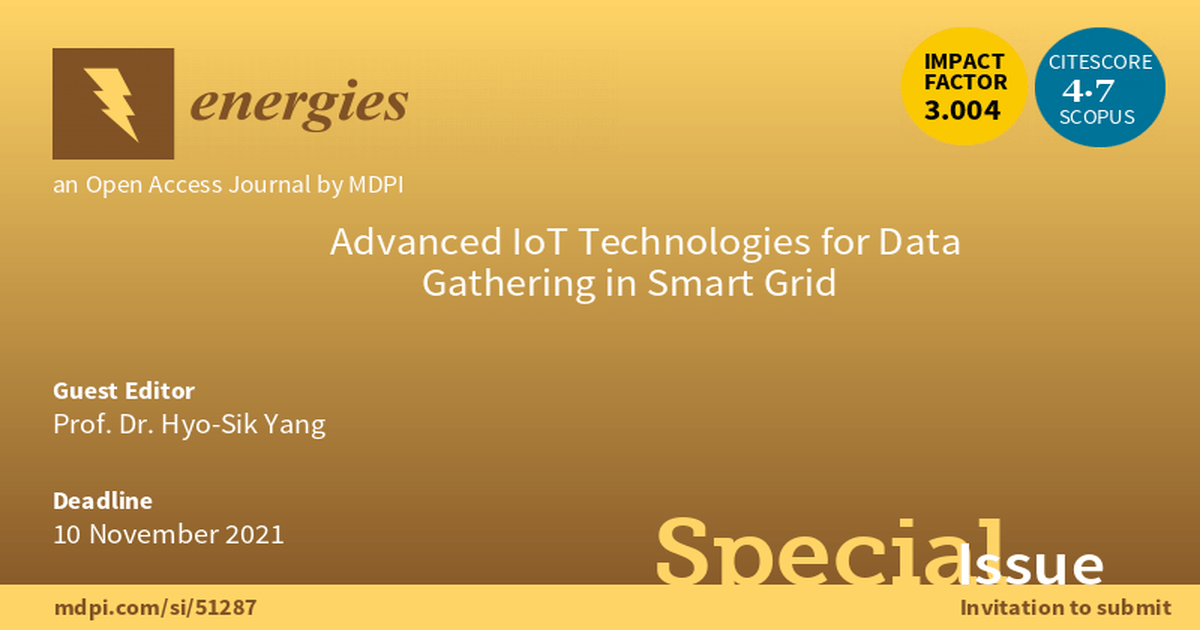Advanced IoT Technologies for Data Gathering in Smart Grid
A special issue of Energies (ISSN 1996-1073). This special issue belongs to the section "A1: Smart Grids and Microgrids".
Deadline for manuscript submissions: closed (10 November 2021) | Viewed by 9161

Special Issue Editor
Special Issue Information
Dear Colleagues,
We invite submissions to a Special Issue of Energies on the subject of “Advanced IoT Technologies for Data Gathering in Smart Grid”. In recent years, communication technology has converged with electrical power networks, which has led to the new concept of a smart grid. By using digital data communication, data gathered at a specific point can be reused in many other applications, whereas legacy analog data can be delivered using copper wires to the limited applications. The traditional client-server based communication concept is not efficient in the new era of the smart grid due to the large volume of data and distributed nature of data origin. IoT communication protocols use the publish–subscribe concept of data exchange and are suitable for many-to-many communication paradigm. The IoT protocol will pave the way for the use of widespread data anywhere and make big data applications possible.
The Special Issue encourages high-quality unpubished contribution on recent advances in IoT applications for data gathering in a smart grid. Topics of interest for publication include but are not limited to: IoT protocols for data gathering; IoT protocols for monitoring; IoT protocols for big data applications; Communication architecture for data gathering; Big data applications; Sensor network in a smart grid; Micro grid data gathering; IoT data analysis for smart grid; IEC 61850 to IoT protocol mapping.
Prof. Dr. Hyo-Sik Yang
Guest Editor
Manuscript Submission Information
Manuscripts should be submitted online at www.mdpi.com by registering and logging in to this website. Once you are registered, click here to go to the submission form. Manuscripts can be submitted until the deadline. All submissions that pass pre-check are peer-reviewed. Accepted papers will be published continuously in the journal (as soon as accepted) and will be listed together on the special issue website. Research articles, review articles as well as short communications are invited. For planned papers, a title and short abstract (about 100 words) can be sent to the Editorial Office for announcement on this website.
Submitted manuscripts should not have been published previously, nor be under consideration for publication elsewhere (except conference proceedings papers). All manuscripts are thoroughly refereed through a single-blind peer-review process. A guide for authors and other relevant information for submission of manuscripts is available on the Instructions for Authors page. Energies is an international peer-reviewed open access semimonthly journal published by MDPI.
Please visit the Instructions for Authors page before submitting a manuscript. The Article Processing Charge (APC) for publication in this open access journal is 2600 CHF (Swiss Francs). Submitted papers should be well formatted and use good English. Authors may use MDPI's English editing service prior to publication or during author revisions.
Keywords
- IoT protocols for data gathering
- IoT protocols for monitoring
- IoT protocols for big data applications
- Communication architecture for data gathering
- Big data applications
- Sensor network in a smart grid
- Micro grid data gathering
- IoT data analysis for smart grid
- IEC 61850 to IoT protocol mapping





